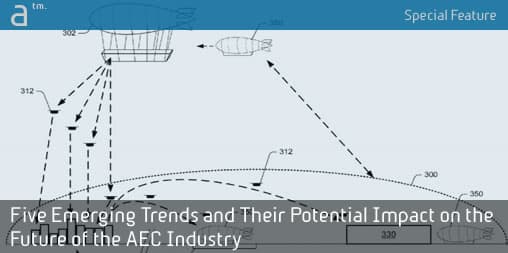Architosh already highlights leading edge technology trends in AEC. Our AIA BEST of SHOW honors awards has specific categories for highlighting actual products on the cutting edge. And our deeper discussion on these applications and technologies look at wholesale themes.
However, we can look further afield; we can examine things that are still on the fringe of society and perhaps just a bit closer than the fringe? Autonomous vehicles and drones are a perfect example of the latter. Adaptive learning and crowd learning are examples of the former.
Here are five technology trends with broad implications for society, and some narrower forecasts and observations on how they may impact the AEC (architecture, engineering, and construction) industry and the professionals that serve its stakeholders.
Trend 1: Autonomous Vehicles
We have all heard a lot lately about autonomous vehicles and how shortly humans may not even be allowed by law actually to drive. If such tech futures come true what will happen to our cities, towns, and even buildings and how will this impact the field architecture, urban design, and planning?
The answer to these questions is varied, complicated, and intensely interesting. A lot will depend on other technology trends and how they bear out, as well. But here are some important forecasts.

01 – Your Tesla car in 10-20 years time may be a passive income generator. When you are at work or on vacation, your Tesla will become an autonomous Uber-like vehicle, joining the rental Tesla fleet on command from the control of your phone app. This will change how people view vehicles and plan for their use and storage. Image: Tesla, All rights reserved.
Before humans are forbidden by law from driving both advanced Lidar and WiFi technology will need to mate up with upgraded highway systems and town roads. Highways may get dedicated “autonomous lanes” while some towns may have dedicated autonomous streets. Engineers involved in roads, bridges, and tunnels will all need to skill-up in the sensor technologies and new design requirements and methodologies in the era of autonomous vehicles.
Moreover, architects will be challenged with finding new uses for parking structures, as more autonomous cars drop off their occupants and then either drive home, drive to a charging station, or become rental rides for other people who do not own cars at all. Telsa has expressed a vision where exactly such a thing happens—once Tesla’s vehicles are fully autonomous owners will be able to add them to the Tesla shared fleet from an app on their phone. A world where your car is working for money while you are at work or on vacation says two things: fewer people will own cars and how cars operate autonomously will change everything from roads, drop-offs, and our perhaps garages at home.
MORE: It’s Time To Think About Living In Parking Garages
When will all this play out? Futurist Amy Webb and her company predict 20-30 years but things could happen sooner. AEC pros in their 20’s and 30’s should all start thinking about these changes today and develop expertise and creative solutions to these environmental changes.
Trend 2: Drones
Today AEC pros use drones to fly over construction sites and take aerial photography. We have all seen the ones over the new Apple Campus, for example. Yet, Amazon and others predict a future where drones deliver goods directly to our homes. And Amazon just was just awarded a US patent on a Zeppelin like airship which shoots out delivery drones. Sound like Star Wars to you? (see image 02)
MORE: Amazon patented a hovering airship warehouse that shoots out delivery drones
How might drone delivery affect buildings?
In the near future armies of drones will fill the sky, in areas such as law enforcement, delivery of goods, clandestine operations, and microdrones. The latter are tiny drones small enough to investigate collapsed buildings and bridges and areas with hazardous materials. Regular sized drones can also be used by building inspectors to review completed work in hard-to-reach or dangerous places (like sloping roofs during icy winters). Structural and civil engineers can use such microdrones as part of their investigative services, and mechanical engineers can use microdrones to inspect the insides of ductwork in buildings.

02 – Amazon looks to have huge plans for drone delivery mechanisms, including airship warehouses that hover over major metropolitan areas. Amazon’s hovering aircraft warehouse. Image: USPTO. All rights reserved.
Back to drones for delivery. The FAA has not yet regulated airspace for drones, but experts predict that to be completed in 3-5 years. Amazon’s airship patents currently violate FAA regulations. Regulated airspace for drones will likely operate in zero – 200 feet for hobbyists and journalists, etc., and 200 – 400 feet for commercial drones (e.g., UPS, Amazon, etc.).
As futurist Amy Webb has noted in her book, The Signals Are Talking: Why Today’s Fringe Is Tomorrow’s Mainstream, changes to FAA rules regarding airspace for drones could impact future urban development, including height limitations on skyscrapers.
next page: Adaptive Learning, Crowd Learning, and Smart Cities





Reader Comments
[…] next page: Adaptive Learning, Crowd Learning, and Smart Cities […]
Comments are closed.